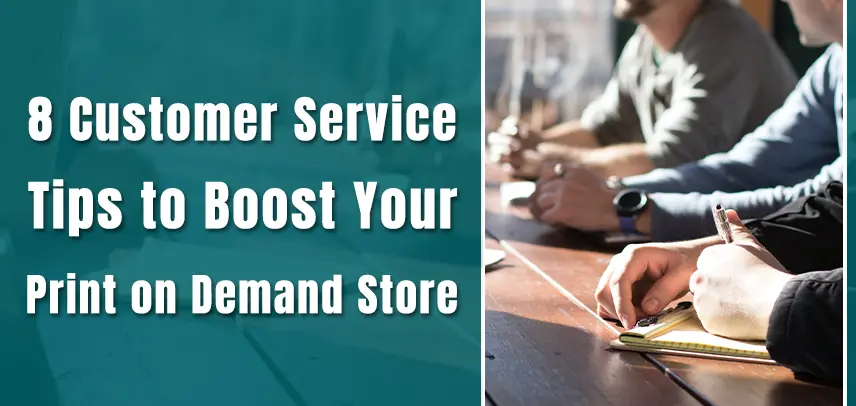
8 Essential Customer Service Tips for Your Print on Demand Store
In the crowded world of e-commerce, a great product gets you started, but outstanding customer service is what builds a brand. For your print-on-demand (POD) business, the way you handle customer support can make or break your reputation. Getting it right leads to loyal customers, glowing reviews, and word-of-mouth growth. These eight tips will help you create a customer service strategy that sets your POD shop apart.
Page overview:
1. Know the POD Model Inside and Out
2. Write Clear Policies and a Helpful FAQ
3. Respond to Customers Quickly
4. Proactively Update Customers on Order Status
5. Offer Multiple Ways to Get Help
6. Solve Problems with Confidence and Speed
7. Treat Complaints as Free Feedback
1. Know the POD Model Inside and Out
To give great support, you first need to be an expert on your own business model. Remember, you don't hold any inventory. When a customer places an order, it goes directly to your printing partner, who produces and ships it.
This process directly impacts your customers, so you need to be clear about:
- No Exchanges: Since every item is printed on demand, you can't offer exchanges for different sizes or colors if a customer makes a mistake.
- Production Times: Printing and preparing an order can take anywhere from 2 to 7 business days before it even ships.
- Separate Shipping: Your POD provider handles all shipping, so delivery times depend on their carriers.
- Quality Control: If there's a print error or damage, the process involves a reprint or refund from your provider, not a return to you.
Being upfront about these realities prevents frustration and sets the right expectations from the start.
2. Write Clear Policies and a Helpful FAQ
Don't make your customers guess. A well-defined set of store policies is your first line of defense against confusion. Post this information where it's easy to find.
Your Store Policies Should Cover:
- Estimated production and shipping times.
- Shipping rates and options.
- Accepted payment methods.
- Clear instructions for refunds or cancellations.
Your FAQ Page Should Answer:
- How do I care for my printed shirt?
- What should I do if there's an issue with my order?
- What happens if my package gets lost?
The more you answer in advance, the fewer support tickets you'll have to manage later.

3. Respond to Customers Quickly
When a customer reaches out, speed matters. Even if you don't have an immediate solution, a quick reply that says, "Thanks for your message, we're looking into it," shows you're paying attention. This simple step can prevent a small issue from escalating. Use email autoresponders or chatbots for an instant confirmation, then follow up with a personal, detailed solution as soon as you can.
4. Proactively Update Customers on Order Status
Keep your customers in the loop. Instead of making them wonder about their order, send proactive updates. Automated emails are perfect for this. Set them up to notify customers at key stages:
- When the order is confirmed.
- When it goes into production.
- When it has shipped (with tracking info).
- A follow-up to confirm it was delivered.
Informed customers are happy customers who are less likely to flood your inbox with "Where is my order?" questions.
5. Offer Multiple Ways to Get Help
People have different preferences for how they communicate. Cater to this by offering a few support channels and be clear about the expected response time for each.
- Live Chat: Best for urgent, simple questions.
- Email: Good for standard inquiries (aim to reply within 24 hours).
- Contact Form: Suitable for non-urgent issues (reply within 1-3 days).
6. Solve Problems with Confidence and Speed
Mistakes happen. When they do, your goal is to resolve them as painlessly as possible. Train your support team (or yourself) on your POD provider's process for reprints and refunds. Empower your team to make decisions—like offering a discount or a small freebie—to fix a negative experience and keep a customer's loyalty. A quick, confident resolution can turn an unhappy customer into a fan.
7. Treat Complaints as Free Feedback
No one likes getting complaints, but they are a goldmine of information. Every piece of negative feedback highlights a weak spot in your business.
- Repeated shipping delays? It might be time to review your POD partner.
- Complaints about print quality? Re-evaluate the products you're offering.
- Confused customers? Your product descriptions may need an update.
Use this feedback to constantly improve your operations and prevent future problems.

8. Go the Extra Mile to Delight Your Customers
Solving problems is important, but true brand loyalty comes from creating positive, memorable experiences. Look for small ways to exceed expectations.
- Include a handwritten thank-you note.
- Toss in a free sticker with every order.
- Occasionally upgrade a customer to faster shipping for free.
- Create a simple loyalty program with discounts for repeat buyers.
These small, personal touches show you care and give customers a great story to share.
Great Service Is Your Strongest Asset
In the print-on-demand business, your customer service is just as important as your designs. By being transparent, responsive, and proactive, you can build a reputation for being a brand that truly cares. This approach doesn't just solve problems—it builds the loyalty and trust that will fuel your store's growth for years to come.



